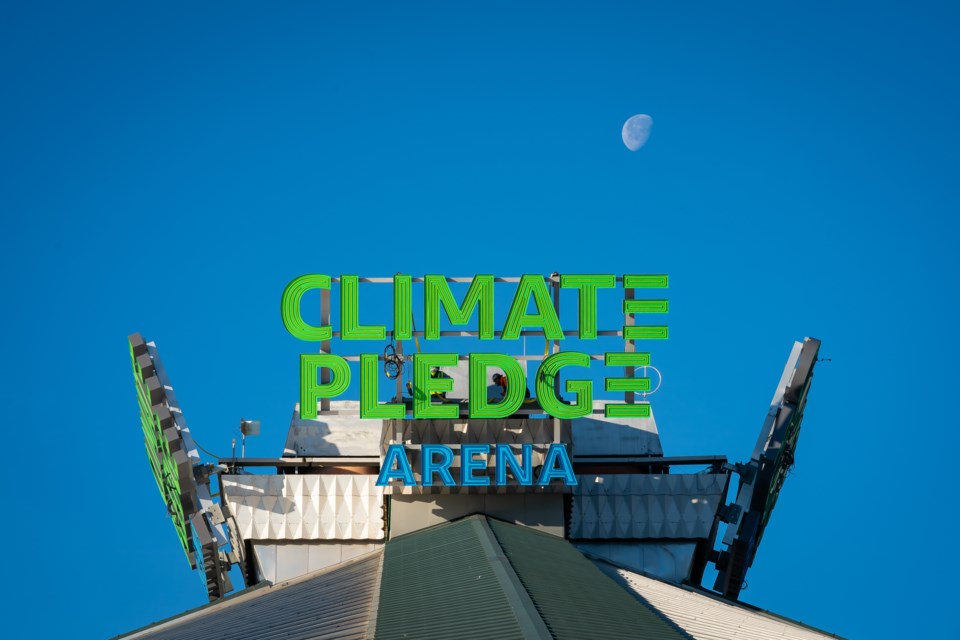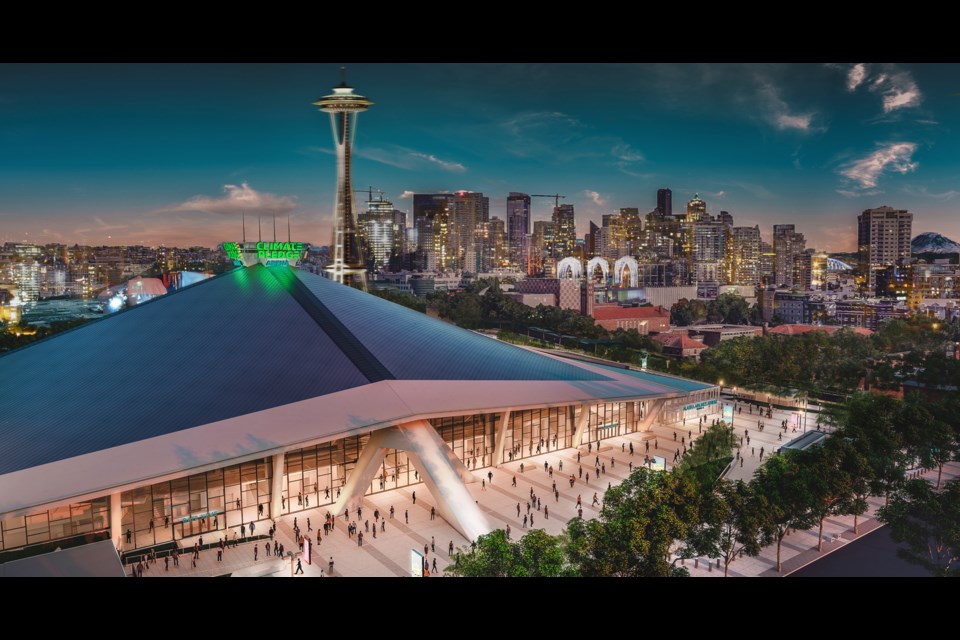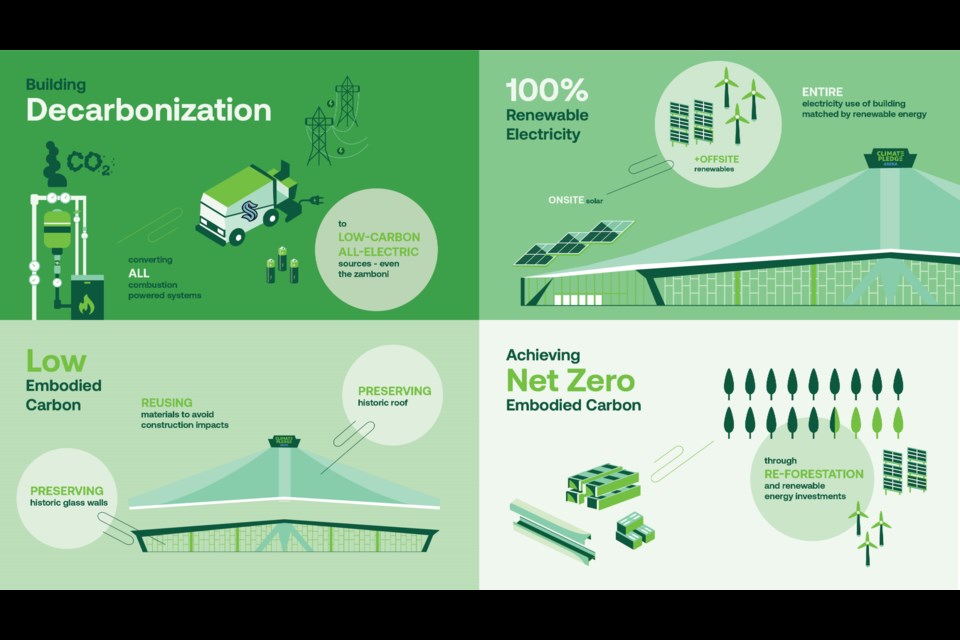Disappointed in the Kingsway
Entertainment District’s location, Jason McLennan wants to see the new arena at the very least be net-zero.
10 h By: Tyler Clarke



10 h By: Tyler Clarke



A rundown of environmental features that have been included in the new Climate Pledge Arena in Seattle. (Submitted)Expand
A world-renowned figure in the field of architecture and the green building movement has been watching with great interest as the Kingsway Entertainment District project has proceeded.
“I’d like to see Sudbury thrive and live up to its potential, and that’s why I was disappointed to learn about the idea of moving the arena out of downtown,” Jason McLennan said.
“If you pull the focus away from downtowns you really diminish it and all you do is increase vehicle travel and you create urban sprawl and you hurt public transportation and so on and so forth, and it’s really an unfortunate move.”
Although his base of operations is currently in Seattle, McLennan was born and raised in Sudbury, still has family in the city and wants to see his home community succeed.
Last year, he presented an idea for Sudbury’s Superstack which he envisioned as becoming the world’s tallest solar energy source.
McLennan has not been involved in the Sudbury arena project and clarified he doesn’t want to criticize the people behind the project, as he doesn’t know them and hasn’t spoken with them.
That said, he yields significant expertise in the fields of not only the green building movement but also arenas in particular.
McLennan and his firm McLennan Design, which he is CEO of, served as the lead sustainability consultant for the Climate Pledge Arena in Seattle, Wash. The arena will serve the Seattle Kraken NHL team and come at a cost greater than $1 billion.
“It will be the greenest arena on the planet and sets new benchmarks for sustainability as well as being great for the city,” he said. “It’s a great example of thinking differently about existing assets and making it work. If you can do it for the NHL you can do it for the OHL.”
His nod to the OHL is in reference to the Sudbury Wolves, whose games are poised to shift from the downtown-based Sudbury Community Arena to the Kingsway Entertainment District located off of The Kingsway near the Sudbury Landfill Site after it opens in late 2024.
The arena project is a new build that includes a $100-million capital investment by the municipality and cost-sharing agreements with partners, and has been approved by Greater Sudbury city council, which is expected to receive an update during their Sept. 14 council meeting.
Although the city’s elected officials considered downtown for a new or renovated arena in 2017, a 6-6 vote by the city council of the day defeated the motion, shifting their attention to its currently approved location.
Prior to a decision was made in Seattle, McLennan said the community was shown a report on how their historic arena, built in the 1960s, could be modernized and improve its surrounding area.
“When the community saw that they were incredibly excited about it,” he said. “We were reusing the structure, the roof, the infrastructure.”
In Sudbury, Ward 4 Coun. Geoff McCausland presented a motion in June for city staff to undertake an analysis of potential approaches for modernizing the Sudbury Community Arena, but it was narrowly defeated.
“If I was a citizen of Sudbury, I would have wanted to see beautiful designs and renderings and analysis of how the existing arena could have been updated,” McLennan said.
But, given that shutting down the KED at this point would require a three-quarters vote of council, which doesn’t appear to be their current bend, its currently approved location stands.
McLennan said that if they stay firm on the location, the city should at the very least construct a net-zero building.
“There would be no energy bill, no hydro bill, it would be a living building as I call it; there would be no water bill,” he said, adding that city council’s 2019 unanimous declaration of a climate emergency behooves them to keep environmental stewardship at top of mind.
“It’s not only because of the environmental benefits but also the economic benefits, and there’s a lot of misinformation and old information people have about it having to cost a lot,” he said.
“It’s about making investments in the future. ... The economic returns are very positive, and that’s why we’re seeing more and more facilities going green.”
Those behind the Climate Pledge Arena in Seattle have made a number of environmental commitments, including that the facility be carbon neutral, utilize no single-use plastics, conserve water and produce zero waste.
The arena, McLennan said, will be powered completely by renewable energy and will hook up with solar panels both on-site and off-site.
“We’re even making our ice from rainwater, so we’re capturing rainwater and making what I think will be the greenest ice in the NHL.”
Although he has been watching the KED proceed from afar, McLennan said he’d be eager to speak with city council and stakeholders if they are so inclined.
“I’d be open to sharing my experience and knowledge in working with arenas and with the NHL and working with cities,” he said. “I’ve been a consultant to quite a few cities over the years, and I’m happy to talk to the city.
“I really think the city needs to understand in 10 years from now what this would look like, both in location and truly what it would look like if they did what we did in Seattle and reinvested in existing assets.”
City of Greater Sudbury Energy and Emissions Plan
In response to an inquiry about City of Greater Sudbury policies related to environmentally friendly builds, a communications representative pointed to the Community Energy and Emissions Plan (CEEP).
This, they explained, is the city’s long-term plan to reduce carbon emissions. The plan came in response to city council’s 2019 climate emergency declaration and works toward achieving net-zero emissions by 2050.
The plan includes 18 goals in eight strategy sectors, including three under the efficient buildings umbrella, including:
Goal 2: Periodically increase the energy efficiency of new buildings until all new buildings in 2030 onward are Passive House energy efficiency compliant.
Goal 3: The existing building stock is retrofit for 50 per cent increased energy efficiency by 2040 and large buildings are routinely recommissioned.
Goal 4: Achieve net-zero emissions in City buildings by 2040.
Under Goal 3, the city is striving to develop an energy efficiency retrofits program for which they recently received $170,000 in funding from the Federation of Canadian Municipalities to do a study comparing home retrofit financing models.
Under Goal 4, the city is developing a prioritized list of municipal buildings to perform energy audits, payback analyzes and retrofits on starting with the highest priority buildings.
As for the KED, the spokesperson noted the city is currently looking at how the CEEP goals will tie into the project, which will be outlined in future reports to city council.
In a July 14 report to city council, it’s noted, “From the perspective of the CEEP, the project respects the objective to minimize the production of greenhouse gases in the operation of new assets.”
Tyler Clarke covers city hall and political affairs for Sudbury.com.
A world-renowned figure in the field of architecture and the green building movement has been watching with great interest as the Kingsway Entertainment District project has proceeded.
“I’d like to see Sudbury thrive and live up to its potential, and that’s why I was disappointed to learn about the idea of moving the arena out of downtown,” Jason McLennan said.
“If you pull the focus away from downtowns you really diminish it and all you do is increase vehicle travel and you create urban sprawl and you hurt public transportation and so on and so forth, and it’s really an unfortunate move.”
Although his base of operations is currently in Seattle, McLennan was born and raised in Sudbury, still has family in the city and wants to see his home community succeed.
Last year, he presented an idea for Sudbury’s Superstack which he envisioned as becoming the world’s tallest solar energy source.
McLennan has not been involved in the Sudbury arena project and clarified he doesn’t want to criticize the people behind the project, as he doesn’t know them and hasn’t spoken with them.
That said, he yields significant expertise in the fields of not only the green building movement but also arenas in particular.
McLennan and his firm McLennan Design, which he is CEO of, served as the lead sustainability consultant for the Climate Pledge Arena in Seattle, Wash. The arena will serve the Seattle Kraken NHL team and come at a cost greater than $1 billion.
“It will be the greenest arena on the planet and sets new benchmarks for sustainability as well as being great for the city,” he said. “It’s a great example of thinking differently about existing assets and making it work. If you can do it for the NHL you can do it for the OHL.”
His nod to the OHL is in reference to the Sudbury Wolves, whose games are poised to shift from the downtown-based Sudbury Community Arena to the Kingsway Entertainment District located off of The Kingsway near the Sudbury Landfill Site after it opens in late 2024.
The arena project is a new build that includes a $100-million capital investment by the municipality and cost-sharing agreements with partners, and has been approved by Greater Sudbury city council, which is expected to receive an update during their Sept. 14 council meeting.
Although the city’s elected officials considered downtown for a new or renovated arena in 2017, a 6-6 vote by the city council of the day defeated the motion, shifting their attention to its currently approved location.
Prior to a decision was made in Seattle, McLennan said the community was shown a report on how their historic arena, built in the 1960s, could be modernized and improve its surrounding area.
“When the community saw that they were incredibly excited about it,” he said. “We were reusing the structure, the roof, the infrastructure.”
In Sudbury, Ward 4 Coun. Geoff McCausland presented a motion in June for city staff to undertake an analysis of potential approaches for modernizing the Sudbury Community Arena, but it was narrowly defeated.
“If I was a citizen of Sudbury, I would have wanted to see beautiful designs and renderings and analysis of how the existing arena could have been updated,” McLennan said.
But, given that shutting down the KED at this point would require a three-quarters vote of council, which doesn’t appear to be their current bend, its currently approved location stands.
McLennan said that if they stay firm on the location, the city should at the very least construct a net-zero building.
“There would be no energy bill, no hydro bill, it would be a living building as I call it; there would be no water bill,” he said, adding that city council’s 2019 unanimous declaration of a climate emergency behooves them to keep environmental stewardship at top of mind.
“It’s not only because of the environmental benefits but also the economic benefits, and there’s a lot of misinformation and old information people have about it having to cost a lot,” he said.
“It’s about making investments in the future. ... The economic returns are very positive, and that’s why we’re seeing more and more facilities going green.”
Those behind the Climate Pledge Arena in Seattle have made a number of environmental commitments, including that the facility be carbon neutral, utilize no single-use plastics, conserve water and produce zero waste.
The arena, McLennan said, will be powered completely by renewable energy and will hook up with solar panels both on-site and off-site.
“We’re even making our ice from rainwater, so we’re capturing rainwater and making what I think will be the greenest ice in the NHL.”
Although he has been watching the KED proceed from afar, McLennan said he’d be eager to speak with city council and stakeholders if they are so inclined.
“I’d be open to sharing my experience and knowledge in working with arenas and with the NHL and working with cities,” he said. “I’ve been a consultant to quite a few cities over the years, and I’m happy to talk to the city.
“I really think the city needs to understand in 10 years from now what this would look like, both in location and truly what it would look like if they did what we did in Seattle and reinvested in existing assets.”
City of Greater Sudbury Energy and Emissions Plan
In response to an inquiry about City of Greater Sudbury policies related to environmentally friendly builds, a communications representative pointed to the Community Energy and Emissions Plan (CEEP).
This, they explained, is the city’s long-term plan to reduce carbon emissions. The plan came in response to city council’s 2019 climate emergency declaration and works toward achieving net-zero emissions by 2050.
The plan includes 18 goals in eight strategy sectors, including three under the efficient buildings umbrella, including:
Goal 2: Periodically increase the energy efficiency of new buildings until all new buildings in 2030 onward are Passive House energy efficiency compliant.
Goal 3: The existing building stock is retrofit for 50 per cent increased energy efficiency by 2040 and large buildings are routinely recommissioned.
Goal 4: Achieve net-zero emissions in City buildings by 2040.
Under Goal 3, the city is striving to develop an energy efficiency retrofits program for which they recently received $170,000 in funding from the Federation of Canadian Municipalities to do a study comparing home retrofit financing models.
Under Goal 4, the city is developing a prioritized list of municipal buildings to perform energy audits, payback analyzes and retrofits on starting with the highest priority buildings.
As for the KED, the spokesperson noted the city is currently looking at how the CEEP goals will tie into the project, which will be outlined in future reports to city council.
In a July 14 report to city council, it’s noted, “From the perspective of the CEEP, the project respects the objective to minimize the production of greenhouse gases in the operation of new assets.”
Tyler Clarke covers city hall and political affairs for Sudbury.com.
No comments:
Post a Comment